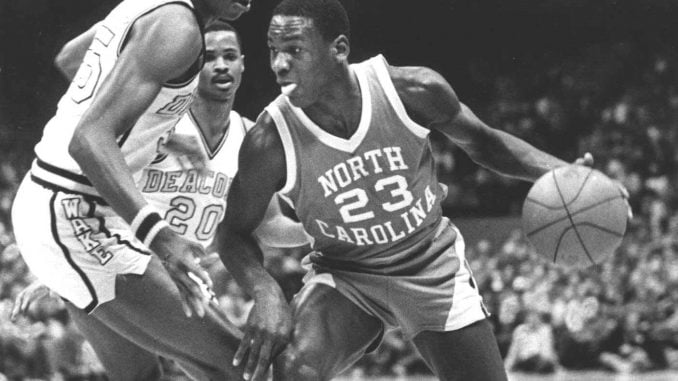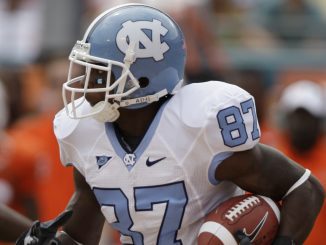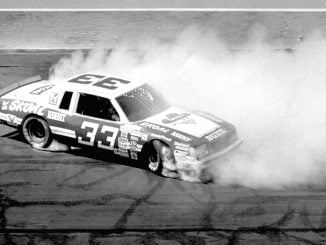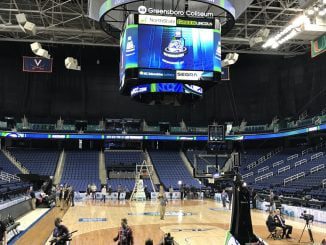
Genius, in the words of the great inventor Thomas Edison, might be 1% inspiration and 99% perspiration. But when it comes to the North State Journal’s now completed 100 in 100 series, it was more like 1% inspiration and 99% boredom.
That’s because the idea came about as a way of passing time while on a long train ride last September.
 While traveling to Maryland for the wedding of a family friend, I came across an article about the Western North Carolina mountains in a magazine found in the seatback pouch in front of me. The story mentioned that Charlie “Choo Choo” Justice was the greatest athlete ever produced by Buncombe County.
While traveling to Maryland for the wedding of a family friend, I came across an article about the Western North Carolina mountains in a magazine found in the seatback pouch in front of me. The story mentioned that Charlie “Choo Choo” Justice was the greatest athlete ever produced by Buncombe County.
With nothing but time on my hands and free Wi-Fi to keep me busy, I then set out to determine the best athlete in every North Carolina county.
I probably wouldn’t have even tried had I known at the time that there were 100 of them. I didn’t even get halfway through the list by the time we pulled into Washington, D.C.’s Union Station. But suffice it to say, the trip didn’t seem quite as long as it could have.
And having done as much research as I already had, I was determined to finish the project.
As it turned out, determining all the picks was the easy part. With fellow sports staff members Cory Lavalette and Shawn Krest, along with NSJ publisher Neal Robbins, contributing to the process, we were able to compile an impressive list of selections.
The hard part was figuring out how to present such a massive undertaking on the pages of a newspaper in which editorial space is always at a premium.
It took the coronavirus pandemic and the shutdown of sports activities around the world to finally create the opportunity.
Over the past 20 weeks, we have told the stories of some of the best-known athletes from around the state. We’ve also introduced you to some whose stories you’d probably never heard before.
Among our favorites is one involving Vance County’s Jason Brown, who walked away from the NFL and a lucrative free agent contract at the age of 29 to become a farmer so he could give something back to society in the name of his brother, who was killed in Iraq while serving in the U.S. military. To date, Brown has donated 100,000 pounds of sweet potatoes to food banks around the state.
Just as inspiring was the story of Dare County’s Emanuel Davis, who saw his father die in a car accident at 9 years old, saw his mother sent to prison when he was in high school and still managed to overcome the adversity and succeed, thanks to the generosity of a volunteer assistant coach and his family, who wrote their version of the movie “The Blind Side.”
On the lighter side, there’s Montgomery County’s Tyrone Horne, who never made it to the major leagues but still managed to end up in the Baseball Hall of Fame because of the “home run cycle” he hit while playing in the minors.
During the series, we learned that Granville County’s Lee “Specs” Meadows was the first player ever to wear glasses in a Major League Baseball game, that heavyweight boxing champion James “Bonecrusher” Smith of Duplin County only became a professional boxer to earn some extra money to buy Christmas presents, and that Lee County’s Herb Thomas had such a good time at the first NASCAR race he attended that he went out, bought a race car and ended up becoming the first driver ever to win multiple Cup championships.
We found out that Rutherford County’s Forrest Burgess was called “Smoky” because of the mountain range near his home, that Graham County pool shark Wade Crane was known as “Boom Boom” because of the sound his powerful breaks made, and that Greene County’s Theodore Edwards got his nickname “Blue” because that’s the color he turned when he nearly choked to death as a baby.
In all, there were 39 football players among the 100 in 100, along with 24 basketball players, 21 baseball players, six race car drivers, five track athletes and three golfers. Other sports represented included professional wrestling, surfing, boxing, tennis, billiards, volleyball, softball, water skiing and, yes, monster trucks.
As diverse as the distribution of sports was, the breakdown between the genders wasn’t nearly as equitable. Ninety-one of the 100 featured athletes were men, while only nine were women.
North Carolina led the way among the 35 colleges that had at least one selection with 19 athletes, followed by NC State with 10, Duke with eight, Wake Forest with five.
There were 34 members of the North Carolina Sports Hall of Fame, five members each of the baseball and basketball halls of fame, four NASCAR Hall of Famers and three enshrined in the College Football Hall of Fame.
Seven of the honorees played multiple sports in either college or professionally.
Four (Michael Jordan, Richard Petty, Harry Gant and Mike Quick) appeared in movies or television shows. Three (Jordan, Dominique Wilkins and David Thompson) participated in NBA Slam Dunk Contests. Two (Thompson and James Worthy) won Final Four Most Outstanding Player awards, and one — Catfish Hunter — pitched a perfect game.
There were five Super Bowl champions, five World Series champions, four NBA champions, four NCAA basketball champions, three Olympic gold medalists and a college football national champion.
At around 330 pounds, hulking defensive tackle Chester McGlockton was the heaviest selection during his playing days. At 7-foot-2, Avery County’s Tom Burleson was the tallest member of the 100 in 100, while 5-foot-5 Cetera Degraffenreid of Jackson County was the smallest.
And that, as someone other than Edison once said, is the long and short of the story.



